 |
[ Outlaw Genealogy | Bruce
History | Lost Chords ] [ Projects | News | FAQ | Suggestions | Search | HotLinks | Resources | Ufo ] |
 |
[ Outlaw Genealogy | Bruce
History | Lost Chords ] [ Projects | News | FAQ | Suggestions | Search | HotLinks | Resources | Ufo ] |
Barnwell Priory was an Augustinian priory at Barnwell in Cambridgeshire, founded as a house of Canons Regular. It was home to the Barnwell Chronicler, an anonymous chronicler writing during and about the reign of John of England. ( Reign 6 April 1199 – 19 October 1216 )
Both St. John's Hospital and Barnwell Priory were built on common land
The name 'Barnwell' is possibly derived from an Anglo-Saxon placename meaning children's well
969 - Ramsey Abbey was founded by Ailwyn - Aylwin, foster brother of King Edgar , - Alfwold (d. 990), younger brother of Aylwin granted - Bythorn - Kingston / Wistow - was royal demesne and belonged to King Edgar
1100 - PAYNE
PEVEREL, son
of William Peverel the Elder, returns from Jerusalam - starts the Fraternity
of the Holy Sepulcher a Chivalric Order. He was awarded lands and holdings
in Salop in addition to his holdings in Bourne, Barnwell and Cambridge...he
built the magnificent church of the Holy Sepulcher in Cambridge near the
Castle
1112 - Pain
Peverel founds Barnwell Priory at age 30 moving the 6 canons
from St Giles to 30 canon's and 13 acres
1121 - Pain Peverel died in 1121 he was buried at Barnwell Priory.
1130 - The
Round Church of Cambridge was built in about 1130 and was
originally a wayfarers' chapel
1133 - Payne
Peverel dies on Crusade in Jerusalem - There is some doubt about
the date of Pagan Peverel's death
1121-1148 - William Peverel
of Shropshire succeeded to the barony of Bourn and the patronage of the Priory.
He died on the Second Crusade (in 1148)
1211 - The
Cambridge Fair was
granted by King John with the revenues from the fair going to the Priory of
Barnwell - one of the oldest fairs
in the UK
1279 - Peasants in Bourn with three or more holdings - Richard Houtclawe (Outlawe) 4 holdings - 29 acres
1329 - Bourn raiding party of Kingston - John Outlawe and others, rescue 2 horses for the "lord" Priory of Bernewelle - Pg 64/65
1339 - The parson of the church of Potton was robbed in 1339 of wheat, barley, beans, peas and other goods and chattels to the value of forty marks by William, son of William de Hurle of Potton, John Wymond of Potton and John Lettice of Potton, The same William de Hurle and another assaulted Reginald Outlawe, parson of the church of Esthattelee at Potton and wounded him, and William was presented as a common assaulter and disturber of the peace. - THE LANDS OF THE SCOTTISH KINGS IN ENGLAND - Potton - Esthattele = East Hatley St. Denis - (Cambridgeshire)
1340 - Presentation of Reginald le Outlawe, parson of the church of Esthattele, in the diocese of Ely, to the church, of Risshenden, in the diocese of Lincoln, in the king's gift by reason of the temporalities of the priory of Lenton being in his hands, on an exchange of benefices with Hugh de Luffenham. [ Esthattele is connected to Barnwell Abbey - St Michaels Cambridge - St John's Hospital - John de Hattele - Estenhale: its eastern extremity towards Barnwell Priory was called Estenhale] - - Esthattele = East Hatley St. Denis - (Cambridgeshire)
1341 - Reginald Outlawe of Brunne, rect. of E. H. exchanged in 1341 with Thomas de Eure of Blakolmslee. - Esthattele = East Hatley St. Denis
1333 - Lesingham - Thomas de Eure - Rector - Okeburn
1347 - Thomas de Eure - Parish Church of St Mary the Virgin, Great Brickhill - Great Brickhill
1389–1400 - Thomas de Eure - Dean of St. Pauls London
1347 - Grant to Henry de Tangmere and John de Bernewell, burgesses, of a messuage as in 58, 60, and 61. Messuage - Buildings and land
1352 - Bernewelle Priory acquires Hauteyns Estates 1350 - Henry Outlawe for 2 pence - pg 67
1381 - Peasant's Revolt - Richard II - The man accused of ravishing Robert Martyn's wife was later pardoned...beginning of the end of serfdom in medieval England - One captured rebel leader, when asked the reasons for the revolt, said, "First, and above all . . . the destruction of the Hospitallers. (for suppression of the Templars) - Cambridge townspeople joined the rebellions, burning books and archived documents belonging to the University of Cambridge.
1381/3 - John Outelawe was Bailiff at Bourn/Cambridge 1381-1383 - Pg 98 ( I am assuming he became bailiff AFTER the revolt.)
1386 - Cambridge
Fields: Lease to John Outlawe of Bernwell of four and a half acres, one
and a half roods of arable land in Bernewell fields in various parcels
for twenty years at an annual rent of 10s.
So this seems to be John Outlawe and his
"brothers" from West Dereham and be goes on to become John de
Bernewelle Outlawe at Barnwell Priory....:
1387 - Manumission
of three nativi by licence from the Holy See : John Outelawe senr., John O.
junr., and Thomas. O., lay brethren of Norwich dioc. Bull addressed
to West Derham Abbey. They were born of a free mother, but their father Nichs.
O. / laicus was " servus " of the Bp. fo. 61. - BISHOP ARUNDELL'S
REGISTER. See: The
abbey of St. Albans from 1300 to the dissolution of the monasteries on the
freeing of Villiens (serfs) and the
Peasants Revolt. - Thomas
Arundel
1388 - On 9 September 1388 Parliament met at Cambridge. The king and his court lodged at Barnwell Priory until the end of the session
1392 - Ralph Norton died, and was succeeded by John de Bernewelle, (fn. 213) whose personal name was Outlawe; (fn. 214) possibly a canon of West Dereham, and one of the three brothers of that name, all professed there, who were manumitted by Bishop Arundel with papal permission in 1387 at the request of the Bishop of Norwich. (manumitted - to free) - A lease involving the tithes of Holy Trinity, Cambridge, was negotiated between Barnwell and West Dereham after Bernewelle [ John Outlawe ] became prior.
1404 - Gift
by William Britlyngg of Cambridge, Hugh Plouwryght and Richard Outlawe, executors
of the will of Robert Martyn of Cambridge, to Adam Leveryngton of Cambridge,
chandler, and Margaret, his wife, of a tenement in St Bene't parish. Given at Cambridge
- 20 Apr. 1404.
1408 - John de Bernwelle Outlawe died
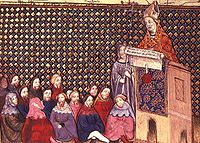 Thomas Arundel
- (Thomas
FitzAlan) - Bishop of Ely
- A younger son of Richard
Fitzalan, 10th Earl of Arundel, he was papally provided as Bishop
of Ely on 13 August 1373 entirely by reason of his father's status and
financial leverage with the Crown during the dotage of Edward
III, happily abandoning his student days at Oxford, from which he gained
little pleasure.[1]
A hugely wealthy near-sinecure, Ely seems to have captured the young bishop's
genuine interest until his brother's political opposition to Richard II's
policies both at home and towards France grew rancorous and dragged him in. In
an extremely grave crisis, teetering towards civil war, 1386-8, the bishop found
himself, at least in formal terms, right at the front of the dangerous attempts
by five leading temporal lords to purge the king's advisors and control future
policy.... Arundel served twice as Lord
Chancellor, during the reign of King
Richard II, first, entirely against the king's wishes, from 1386 to
1389, and again from 1391 to 1396
Thomas Arundel
- (Thomas
FitzAlan) - Bishop of Ely
- A younger son of Richard
Fitzalan, 10th Earl of Arundel, he was papally provided as Bishop
of Ely on 13 August 1373 entirely by reason of his father's status and
financial leverage with the Crown during the dotage of Edward
III, happily abandoning his student days at Oxford, from which he gained
little pleasure.[1]
A hugely wealthy near-sinecure, Ely seems to have captured the young bishop's
genuine interest until his brother's political opposition to Richard II's
policies both at home and towards France grew rancorous and dragged him in. In
an extremely grave crisis, teetering towards civil war, 1386-8, the bishop found
himself, at least in formal terms, right at the front of the dangerous attempts
by five leading temporal lords to purge the king's advisors and control future
policy.... Arundel served twice as Lord
Chancellor, during the reign of King
Richard II, first, entirely against the king's wishes, from 1386 to
1389, and again from 1391 to 1396
The Heads of Religious Houses England and Wales III, 1377-1540_index Bernewell alias Outlawe, John de, pr. Barnwell
Houses of Augustinian canons - Priory of Barnwell British History Online
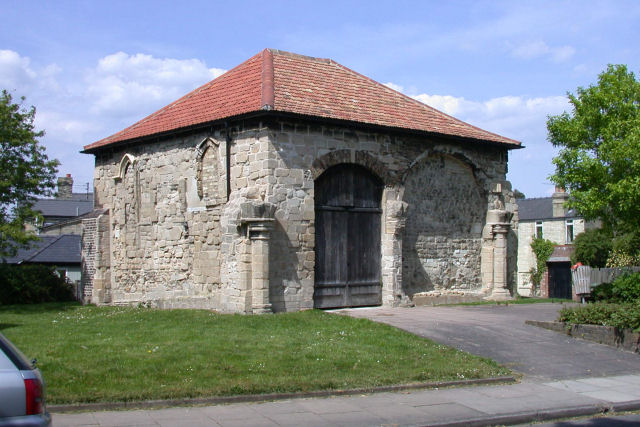
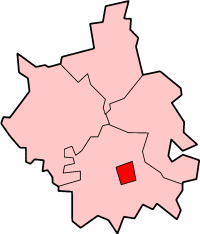
The Cellarer's Chequer, part of the old Barnwell Priory
8. THE PRIORY OF BARNWELL
The house of Canons Regular at Cambridge which became the Priory of Barnwell was among the earliest foundations of this Order in England.
Picot, lord of Bourn and Madingley, and sheriff of Cambridgeshire at the time of the Domesday Survey, fulfilled a vow made by his wife Hugoline, when she fell ill at Cambridge, by building a
church of St. Giles by Cambridge Castle, and establishing canons there about
1092.
On 9 September 1388 Parliament met at Cambridge. The king and his court lodged at Barnwell Priory until the end of the session on 17 October. (fn. 208) On 20 September John Waltham, Keeper of the Privy Seal, and one of the most politically minded of the supporters of Richard II, was consecrated in the priory church by Archbishop Courtenay, having been provided to the see of Salisbury. (fn. 209) John Fordham, Richard's treasurer, took his oath of canonical obedience as Bishop of Ely at the priory on 27 September. (fn. 210) ...
Richard II extended the duration of Midsummer Fair from 3 to 14 days; (fn. 211) and in 1394 he intervened to prevent threatened meetings of the commonalty and of members of the University to break up the fair. (fn. 212)
In 1392 Ralph Norton died, and was succeeded by John de Bernewelle, (fn. 213) whose personal name was Outlawe; (fn. 214) possibly a canon of West Dereham, and one of the three brothers of that name, all professed there, who were manumitted by Bishop Arundel with papal permission in 1387 at the request of the Bishop of Norwich. (fn. 215) A lease involving the tithes of Holy Trinity, Cambridge, was negotiated between Barnwell and West Dereham after Bernewelle became prior.
This led to a case before the papal court in 1399, in respect of liability for repairs to the chancel, for which the prior was adjudged responsible. (fn. 216) Soon after the Dissolution, when a former canon of Barnwell was still incumbent of the parochial chapel of St. Andrew there, it was reported that many Barnwell inhabitants resorted to Holy Trinity as their parish church. (fn. 217) St. Andrew's was accounted an integral part of the priory, for when in 1377 the archdeacon's official intervened in a dispute between two women parishioners, it was found that he had exceeded his jurisdiction, the chaplain Dns. Robert 'notoriously dwelling within the said priory' and being exempt from the archdeacon's jurisdiction. On 14 February 1378 the bishop's official called the apparitor of the deanery of Cambridge before him in the chapter-house of Barnwell, Ralph Norton, the prior, the steward, John de Birton, and John de Kirkby, the sacrist, being present, and charged him with having carried his wand of office within the precincts of the priory 'to the injury both of the jurisdiction of the Bishop of Ely and of the exemption and immunity of the Prior and Convent'. The wand was surrendered to the official and restored at the prior's plea after formal apology. (fn. 218)
Inclosures at Chesterton had brought the disputes between the priory and its tenants to a head in the early part of the 15th century. In 1404 as lord of the manor of Chesterton the prior brought a suit against his 'bondsmen and tenants in bondage . . . who had leagued themselves together to refuse their due customs and services' against the provisions of the Statute of Labourers. (fn. 219)
Thomas Paunfield, one of the tenants who had defied the prior, alleged that in 1405 he had been set upon between Cambridge and Sturbridge Chapel by William Downe (who had since become prior) and other canons and servants of the priory acting under the orders of the prior, John Outlawe, assaulted, and deprived of various books and documents. (fn. 220)
In July 1411 the priory 'being of the King's patronage' was taken into his hand, and his half-brother, Thomas Beaufort, appointed keeper, because it had 'through bad governance become charged with great pensions and corrodies and burdened with debt', and many of its lands and churches had been unwisely farmed or alienated. (fn. 221)
Priors of Barnwell (fn. 292)
John de Bernewelle, or Outlawe, elected March 1392, died Nov. 1408
Callaway Family Association - Callaway - Kellaway English Research
Records of the Priory of St Mary and St Radegund
Title Parish of St Andrew - Reference Gray 121-155, 361
18 January 1344 Lease. Prioress and the nuns of St Radegund to Thomas Engayne, burgess of Cambridge, his wife, Katherine, and their son Thomas, a garden in St Andrew's parish at the south end of the town, between a tenement of Reginald de Trumpington and land of the nuns, abutting on the highway and on the nun's land. Rent: 4s; term: their three lives in survivorship, and one day. Witnesses: Bartholomew Morice, mayor of Cambridge, Stephen de Pannfeld, John de Renton, John de Thacsted, Richard Pawe, John de Bernewell et aliis. Creator: Prioress and the nuns.
Barnwell Family Genealogy page
King Henry I granted Pain Peverel 13 acres of land round the springs at Bernewelle to establish a religious household. Canons from St. Giles, situated by the castle on Castle Hill, moved there in 1112 to found the community under the leadership of the saintly Canon Geoffrey of Huntingdon. Sadly he died in the same year. About this time, there is no exact date, the Canons adopted the Rule of St. Augustine and the household became a Priory. Fortunately, a magnificent vellum manuscript exists in the British Museum, "Liber Memorandium Ecclesie Bernewelle", written in 1295, which describes in great detail the foundation of the Priory and the rules governing it.
A new church was built in the Priory grounds and dedicated to St. Andrew, presumably to continue the tradition of Godesone. The church was consecrated by Longchamp, Bishop of Ely on Low Sunday, 21 April 1190. At a slightly later date another small church, also known as the Abbey Church but more correctly as St. Andrew-the-Less (see figure 1 below), was built adjacent to the Priory Church. This building survives and is still used for worship.
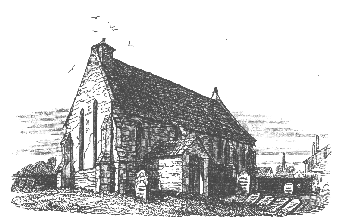 Figure
1. Barnwell Priory Abbey Church
Figure
1. Barnwell Priory Abbey Church
The Priory grew in size and stature and it is perhaps hard for us today to imagine the esteem in which it was held; it was widely acknowledged to be the best in the country. The old midsummer festival was made permanent by King John in 1200. John stayed there in March 1203; Henry III stayed there a number of times and confirmed the right of the priory to hold the midsummer fair. In 1293 Edward I stayed at the castle but stabled his horses at Barnwell. He visited Barnwell again in 1296 and made a splendid gift of wine to the priory. Edward II visited in 1315 and again in February 1326. The priory became very important in the diocese of Ely, various diocesan synods were held at the priory. Parliament met there with Richard II on 9th September to 17 October 1388. Richard II confirmed the right to hold the fair and extended it from 3 days to 14 in 1394 after the University tried to stop the fair. Henry VI stayed there and was treated well in 1438. The priory was surrendered by the last Prior, Jonas Badcock, to Henry VIII on 8 November 1538 and rapidly dismantled; the library was dispersed but the main books have been traced. A site plan of Barnwell Priory was pieced together from excavations and can be found in Clark's book about the Priory. Little remains of the old Priory, although there is an old etching (see figure 2 below) showing a tiny section, said to be the Cellarer's Chequer, being used as a stable. This building has been conserved. There are records of the stones being used in Corpus Christi College. Away from the Priory, about half a mile to the east along Newmarket Road, the leper hospital of St. Mary Magdalene was established; its chapel still remains by the bridge over the railway line. Lepers from the King's court, who recovered there, were given the right to dwell in Comberton.
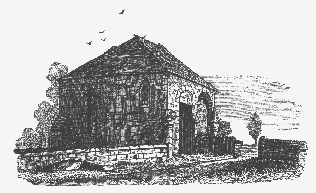 Figure
2. Barnwell Priory
Figure
2. Barnwell Priory
The monks who used the Priory were the Augustinian order (Black Canons) also known as Austin Canons they originally came to England and established themselves at St. Botolph's Priory in Colchester, c. 1106. They spread rapidly, reaching Scotland by 1120. At their height, the Augustinians had over 200 houses in England and Wales. Each of the houses was governed by a prelate, usually a prior, but sometimes, an abbot. The monastic "rule" followed by the Augustinians was that of St. Augustine of Hippo and was not particularly austere. Each of the Austin Canons was a priest and as such was not bound to his house, but was free to have outside responsibilities, such as to a parish.
The Black Canons also ran schools, hospitals and almshouses. Their habit consisted of a hooded black cloak over top of a black cassock with white surplice. As well as Barnwell there were other well known Augustinian houses, these include: Holyrood, St. Andrews, Jedburgh, Lacock, St. Botolph's, Leeds (Kent), Llanthony and Walsingham.
The Priory became the largest religious foundation in the town and had the right to hold a fair every June, which evolved into Midsummer Fair. The Cambridge Fair, like most of the historic fairs in the country, dates back to a charter given in the middle ages. It was granted in 1211 by King John with the revenues from the fair going to the Priory of Barnwell, which was confirmed by Henry III in 1229 and certified to be held on or near the feast of St Etheldreda. The Cambridge Act of 1850 stated that the fair should begin on June 22nd and continue until and including the 25th of June. The fair is opened at 2.30 by the Mayor who used to throw newly minted coins to the children of the town.
Jesus College - University of Cambridge - Publication Scheme - College Estates
The College's main buildings occupy a single site – address Jesus College, Jesus Lane, Cambridge, CB5 8BL. Accommodation for Fellows and students is provided on site and in College-owned houses nearby (in New Square, Jesus Lane, Malcolm Street, Park St and Lower Park St). For historic reasons – by inheritance from the Priory of St Mary and St Radegund and through later endowments and investments – the College also owns other properties in Cambridge and beyond (mostly within Cambridgeshire).
St Radegund - She is the patron saint of Jesus College Cambridge, which was founded on the site of the twelfth-century nunnery of Saint Mary and Saint Radegund. One of the stained glass windows in Jesus College Chapel represents scenes from the life of Saint Radegund, and there is also a statue of Saint Radegund which looks out down Morgan Avenue to the Victoria Avenue gate. This is a companion to the statues of Saint John the Evangelist and the Blessed Virgin Mary, which can be seen on the West and South sides of the Carpenter Building.
1374 - Priory of St Mary and St Radegund - Licence for an easement - The prioress (unnamed) and the nuns to Geoffrey Castre and Margaret, his wife, for an eavesdropping from their house in Walls Lane upon Sarans Croft for the breadth of one foot of St Paul's. Witnesses: William de Horwode, Mayor of Cambridge, Stephen Morice, John de Norton, Robert de Brigham, Henry Outlawe et aliis. - 21 April 1374
1389 - Records of the Priory of St Mary and St Radegund - Gift with Royal licence - Witnesses: Robert Brigham, mayor of Cambridge, John Blankpayn, John Marchal, Richard Martyn, John Norton, Robert Martyn, Richard Outlaw et aliis. (regards Barnwell Priory)
Creator William Rolf
Covering Dates 7 February 1389 ("Data apud Cantebrigg die domenico proximo post festumpurificationisbeate marie virginis Anno Regni Regis Richardi secundi post conquestum duodecimo".)
Content and context
William Rolf of Ixning, chaplain, to the nuns: 1 (Holy Trinity) 2 messuages in Wales Lane in Holy Trinity parish, one next the house of Geoffrey Carter, the other next the King's Ditch. 2
(Barnwell) 5 tofts in Barnwell, within the bounds and liberties of Cambridge, two of them next the messuage of Agnes Deye, and one
next to that of the almoner of
Barnwell Priory, all abutting on the High Street (King's Street). 3 (St Botolph's) a toft in St Botolph's parish, next to the messuage of Thomas Moryz, abutting on the High Street (Trumpington Street). 4 (St Radegund's) a toft, next to a messuage of the nuns, abutting on the King's highway. 5 (Great St Mary's) a shop next the churchyard of St Mary's church, abutting on a shop formerly belonging to Juliana de Beche, with a solar over it extending over the entry to Cambridge market from the churchyard; another shop next the tenement of John Cotton, abutting on the market; another shop in Cutlers' Row, next the shop of Thomas Attefeld. 6) 12d annual rent from Simon de Refham for an entry formerly belonging to the last mentioned shop, leading from a tenement of Refham's to Cutlers' Row. 7 (Cambridge and Barnwell fields) 1/2 acre of land in the fields, lying between the nuns' land and Hinton way.
Witnesses: Robert Brigham, mayor of Cambridge, John Blankpayn, John Marchal, Richard Martyn, John Norton, Robert Martyn,
Richard Outlaw et aliis.
CAMBRIDGE ST ANDREW THE LESS (otherwise BARNWELL)
Monumental inscriptions in the churchyard for the years 1621-1858 and St Andrew the Less, Mill Road Cemetery, reside in the Cambridge Record Office and are available on microfiche from the Cambridgeshire Family History Society Bookstall..
Site of Barnwell Priory, Cambridge, Cambridgeshire, England, United Kingdom
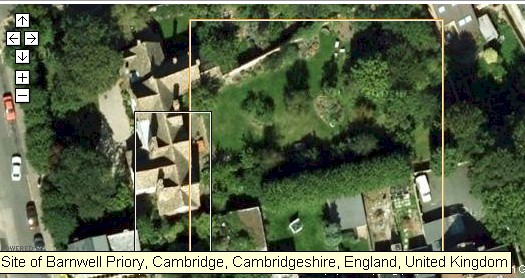 List
of Monastic houses in Cambridgeshire
List
of Monastic houses in Cambridgeshire
Barnwell
Priory, Cambridge
- Augustinian Canons Regular from St.
Giles, Castle Hill, Lode fd. 1092 or c.1112 by Picot, a Norman
lord, and his wife;
dis. 1538; granted to Anthony Brown c.1546; granted to Edward,
Lord Clinton c.1552;
ruins underwent thorough destruction 1810
1100 - PAYNE
PEVEREL, son
of William Peverel the Elder, starts the Fraternity of the Holy Sepulcher a
Chivalric Order. He was awarded lands and holdings in Salop in addition to
his holdings in Bourne, Barnwell and Cambridge...he built the magnificent
church of the Holy Sepulcher in Cambridge near the Castle
1114 - the
Fraternity of the Holy Sepulchre on land given by Abbot
Reinald of Ramsey between 1114 and 1130 - Cambridge Round Church
1130 - The
Round Church of Cambridge was built in about 1130 and was
originally a wayfarers' chapel - but soon became a parish church, served by
the Austin Friars from the nearby Hospital of St. John (now St. John's
College)
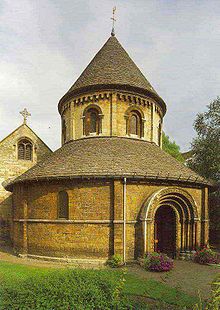 The Holy
Sepulchre, commonly known as The Round Church, is amongst the oldest buildings in Cambridge and one of only four medieval round churches in
England. It is located on the corner of Round Church Street and Bridge Street in central Cambridge, England. Currently home to Christian Heritage, it is one of the most popular tourist destinations in Cambridge.[1]
The Holy
Sepulchre, commonly known as The Round Church, is amongst the oldest buildings in Cambridge and one of only four medieval round churches in
England. It is located on the corner of Round Church Street and Bridge Street in central Cambridge, England. Currently home to Christian Heritage, it is one of the most popular tourist destinations in Cambridge.[1]
Building
The Holy Sepulchre in Cambridge, built around 1130, was probably inspired by the church of the Holy Sepulchre in Jerusalem,[2] based on reports from 11th century Crusaders to the Holy
Land.
The entrance of the church is on the west, through a round-arched doorway. The rotunda is supported by eight large round piers, and the ambulatory is vaulted with a gallery above. The piers support Norman round arches and there is Norman dog-tooth or zig-zag decoration throughout.
Congregation
The congregation of the Round Church outgrew this building, and since 1994 has met
a short distance away at St Andrew the Great, opposite Christ's College in the centre of Cambridge.[4][5]
 1339 - The parson of the church of Potton was
robbed in 1339 of wheat, barley, beans, peas and other goods and chattels to the
value of forty marks by
William, son of William de Hurle of Potton, John Wymond of Potton and John
Lettice of Potton, The same William
de Hurle and another assaulted Reginald
Outlawe, parson of the church of Esthattelee at Potton and wounded him,
and William was presented as a common assaulter and disturber of the peace. - THE LANDS OF THE SCOTTISH KINGS IN ENGLAND - Potton
- Esthattele = East Hatley St. Denis - (Cambridgeshire)
- A feature of the Hatleys is that the more important buildings were once
surrounded by moats. These can still be seen, especially in East Hatley.
1339 - The parson of the church of Potton was
robbed in 1339 of wheat, barley, beans, peas and other goods and chattels to the
value of forty marks by
William, son of William de Hurle of Potton, John Wymond of Potton and John
Lettice of Potton, The same William
de Hurle and another assaulted Reginald
Outlawe, parson of the church of Esthattelee at Potton and wounded him,
and William was presented as a common assaulter and disturber of the peace. - THE LANDS OF THE SCOTTISH KINGS IN ENGLAND - Potton
- Esthattele = East Hatley St. Denis - (Cambridgeshire)
- A feature of the Hatleys is that the more important buildings were once
surrounded by moats. These can still be seen, especially in East Hatley.
[ Esthattele is connected to Barnwell Abbey - St Michaels Cambridge - St John's Hospital - John de Hattele - Estenhale: its eastern extremity towards Barnwell Priory was called Estenhale] - Both St. John's Hospital and Barnwell Priory were built on common land St John's College, Cambridge - The college was founded on the site of the 13th century Hospital of St John in Cambridge at the suggestion of Saint John Fisher, Bishop of Rochester and chaplain to Lady Margaret.
However, Lady Margaret died without having mentioned the foundation of St John's in her will, and it was largely the work of Fisher that ensured that the college was founded. He had to obtain the approval of King Henry VIII of England, the Pope through the intermediary Polydore Vergil, and the Bishop of Ely to suppress the religious hospital and convert it to a college. The college received its charter on April 9, 1511. Further complications arose in obtaining money from the estate of Lady Margaret to pay for the foundation and it was not until October 22, 1512 that a codicil was obtained in the court of the Archbishop of Canterbury.
In November 1512 the Court of Chancery allowed Lady Margaret's executors to pay for the foundation of the college from her estates. When Lady Margaret's executors took over they found most of the old Hospital buildings beyond repair, but repaired and incorporated the Chapel into the new college. A kitchen and hall were added, and an imposing gate tower was constructed for the College Treasury. The doors were to be closed each day at dusk, sealing the monastic community from the outside world. Lady Margaret Beaufort - (31 May 1443 – 29 June 1509), Countess of Richmond and Derby, was the mother of King Henry VII and grandmother of King Henry VIII of England. She was a key figure in the Wars of the Roses, an influential matriarch of the House of Tudor and foundress of two Cambridge colleges. In 1509, she briefly served as regent of England for her grandson.
1200-1250 - Deed
of grant, Lynn - 1d annual rent from a certain [piece of land] 4 feet
wide in Damgate held by Peter Strac
Grant by Laurence Outlaw (utlator) of Len to the
Hospital of the Blessed Mary Magdalen of Len and to the infirm brothers
there for the souls of his parents and his benefactors, the 1d to come from his
purse during his lifetime
Anglo-Norman
Studies Proceedings of ... - Google Books - There
was an epidemic of leprosy in Europe from 1000 to 1200 A.D., which was probably
started by the returning soldiers of the Crusades. Leprosy occurred in
Britain from 625 to 1798, and at one time there were 326 lazar houses
(leprosaria) in Great Britain.
An interesting
connection of Barnwell and Lynn and the St. Mary Magdalene
Leper Chapel, Cambridge
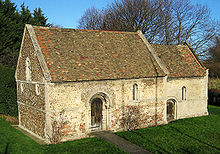 The
Leper Chapel in Cambridge,
also currently known as the Leper Chapel of St. Mary Magdalene, lies on
the east side of Cambridge,
England, off Newmarket
Road just after crossing over the railway line at Barnwell
Junction. It is
probably the oldest surviving building in Cambridge, dating from about 1125,
during the reign of Henry
I.
The
Leper Chapel in Cambridge,
also currently known as the Leper Chapel of St. Mary Magdalene, lies on
the east side of Cambridge,
England, off Newmarket
Road just after crossing over the railway line at Barnwell
Junction. It is
probably the oldest surviving building in Cambridge, dating from about 1125,
during the reign of Henry
I.
The Leper Chapel was part of the buildings of a leprosy hospital which stood a little beyond the outskirts of the city on the road to Bury St. Edmunds. Parts of the east wall (right) are original, but most of the rest of the chapel was rebuilt in the 13th century, although it still retains many Romanesque features.
In 1199 the chapel was given royal dispensation by King John to hold a three day fair in order to raise money to support the lepers. Starting in 1211, the fair took place around the Feast of the Holy Cross (14 September) on Stourbridge Common which lies a little way behind the chapel and continues down to the River Cam.
Stourbridge fair grew to become the largest Medieval fair in Europe and raised so much money that the post of priest at the Leper Chapel became one of the most lucrative jobs in the Church of England. The job was also a sinecure, since the leper hospital had ceased to admit new lepers in 1279, and what few lepers remained were moved to a new colony near Ely. [ New? Not new? referring to the one in Lynn? - it was started in ~1200 ]
The journal of the British Archaeological Association, Volume 11 - Google Books
The church, of Risshenden, in the diocese of Lincoln -
Benefice - benefice was a gift of land (precaria) for life as a reward for services rendered...a priest would receive "temporalities", or pay
[ Esthattele seems to be connected with Barnewell Abbey : St
Michaels Cambridge - St John's Hospital - John de Hattele
- Estenhale:
its eastern extremity towards Barnwell Priory was called Estenhale
]
Then two years later they do this again:
I really don't understand why this was all that important , but I did find Risshenden : the church and town St. Mary's in Rushden in Northamptonshire
The Priory continued its work for 430 years, there being twenty to thirty monks in residence at a time and it is estimated that about one thousand men passed through the Priory in four centuries. It was the tenth richest Priory in England and the wealthiest in the Midlands. Its endowments included the three churches in Nottingham, St. Mary's, St. Peter's and St. Nicholas.
The Valor Ecclesiasticus of 1534 gives the gross income as £387 10s. 10½d (£150,000 as of 2010),[2]
Prior Heath was thrown into prison in February 1538. In March the prior with eight of his monks and four labourers of Lenton were indicted for treason and executed.
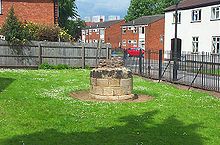 Priory
Church of St. Anthony, Lenton (founded about 1170 as the chapel of St
Anthony's hospital which stood in the courtyard of the priory)
Priory
Church of St. Anthony, Lenton (founded about 1170 as the chapel of St
Anthony's hospital which stood in the courtyard of the priory)
In 1164 the Priory received a charter to hold a fair, and this was the main fair for Nottingham people for trade, larger even than the Nottingham Goose Fair. It would begin on 11 November and run for eight days. (For some seventy years in the thirteenth century the fair's duration was extended to twelve days).
While Lenton's fair was on, no market could be held in Nottingham and such was its size that many of Nottingham's shopkeepers and traders came to the Fair in order to stock up their own shelves.
The Fair continued after the demise of the Priory, though its length was gradually reduced. Its emphasis slowly changed and in the seventeenth century it appears to have acquired a reputation as a great fair for all sorts of horses. In the nineteenth century it was largely frequented by farmers and horse dealers. The Fair finally ceased at the beginning of the twentieth century
House of Cluniac monks - The priory of Lenton British History Online
HOUSE OF CLUNIAC MONKS
3. THE PRIORY OF LENTON
The Cluniac house of Lenton Priory, in the suburbs of Nottingham, was founded by William Peverel in honour of the Holy Trinity, out of love (as the foundation charter expresses it) of divine worship and for the good of the souls of his lord King William, of his wife Queen Matilda, of their son King William and of all their and his ancestors, and also for the health of his present lord King Henry and Queen Matilda and their children William and Matilda, and for the health of his own soul, and those of his wife Matilda and his son William and all their children. He gave the house to God and to the church of Cluni, and to Pontius the abbot there and his successors, but so that it should be free and quit of obligation save the annual payment of a mark of silver as an acknowledgement.
Diocese of Lincoln Lincoln Cathedral
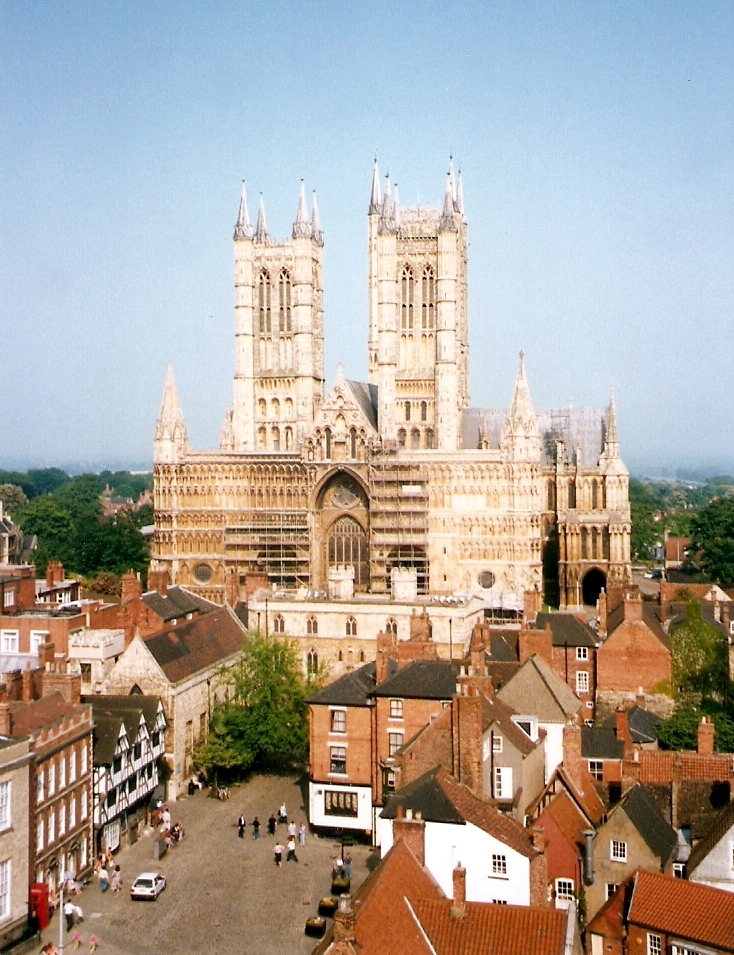
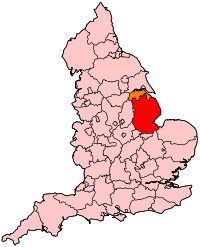 Lincoln Cathedral is one of the finest medieval buildings in
Europe, which towers above Lincoln, a prominent landmark for miles around.
Lincoln Cathedral is one of the finest medieval buildings in
Europe, which towers above Lincoln, a prominent landmark for miles around.
The imposing West Front incorporates the surviving part of the first Romanesque Cathedral dating from 1072. Most of the Cathedral dates from the 13th century when, inspired by the leadership of St Hugh (Bishop from 1186-1200), the Cathedral was re-built in the new gothic style. Later generations added the wonderful carved screen, the 14th century misericords, the Wren Library and the Duncan Grant frescoes.
Risendene (Rushy Vale) - Rusden
There are two "Rusden"'s in England but the Rusden we are interested in is Northamptonshire in the Diocese of Lincoln :
Rushden - is a town and a civil parish in the county of Northamptonshire, England .
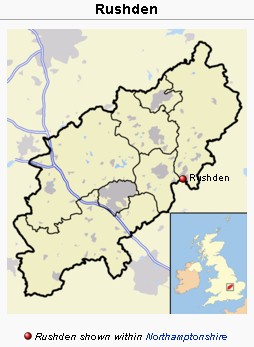 Rushden Research Group St. Mary's History
Rushden Research Group St. Mary's History
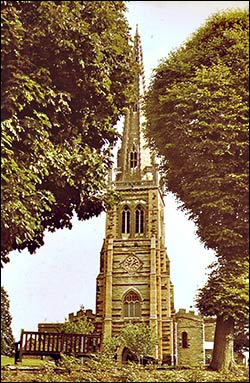 In
1541 the Diocese of Lincoln was split and the Diocese of Peterborough
set up. Rushden, together with most of Northamptonshire was included in the new
diocese. During the 16th century many statues inside and outside
the church were removed by zealous reformers and the walls whitewashed to
cover the paintings. The stone altar was replaced by a wooden one
In
1541 the Diocese of Lincoln was split and the Diocese of Peterborough
set up. Rushden, together with most of Northamptonshire was included in the new
diocese. During the 16th century many statues inside and outside
the church were removed by zealous reformers and the walls whitewashed to
cover the paintings. The stone altar was replaced by a wooden one
Rushden Research Group St Mary's MIs
WEST END OF CHURCH, SOUTH OF BELFRY (C69 to C80)
C70. Window in west wall: Here King Henry at Nottingham confirms the grant of the Church and land at Rushden made by WILLIAM PEVEREL to the Priory of Lenton. For a remembrance before God of all founders and benefactors of this Church the parishioners have caused this window to be made AD 1930.
C71. Rectors of Rushden... HUGH DE LUFFENHAM 1329
The other Rushden in Hertfordshire: Parishes - Rushden British History Online
William Peverel - William's mother seems to have been a Saxon named Maud, daughter of the noble Ingelric. She was married to one Ranulph Peverel, from whom William took his name. Historically, it had been claimed that he was actually the illegitimate son of William the Conqueror, but this cannot be supported by the historical record.[1] William married Adelina of Lancaster, who bore him a daughter Adeliza, born circa 1075, and a son, also named William, born circa 1080.
Whatever his paternity, William Peverel was a favourite of the Conqueror. He was greatly honoured after the Norman Conquest, receiving over a hundred holdings in central England from the king. In 1086, the Domesday Book records William as holding substantial land (162 lordships), collectively called the Honour of Peverel, in Nottinghamshire and Derbyshire, including Nottingham Castle.[2][3] He also built Peveril Castle, Castleton, Derbyshire.
The early history of Caldecote church - CHAPTER ONE
The Barnwell Book
The earliest documentary evidence for a church in Caldecote occurs in the
Liber memorandorum ecclesiae de Bernewelle ("The book of those things relating to the church of Barnwell which are worthy of mentions') which was
begun in 1295 and completed in 1296 according to the standard edition of J. W. Clark (Cambridge, 1907).
This book contains a historical account of Barnwell Priory, and the first reference to Caldecote in fact occurs in the account of
the foundation of St Giles church, Cambridge prior to the foundation of Barnwell Priory itself.
Thus the book states that in 1092 the Norman-born Pycot, who had been made
sheriff of Cambidgeshire (and Lord of Bourn and Madingley) by William the Conqueror, together with his wife Hugolina,
dedicated a church near the castle at Cambridge in honour of St Giles. They did this because Hugolina had been seriously ill and had vowed that if she recovered she would found a religious house in honour of St Giles.
Pycot and his wife thus established six canons regular at St Giles and endowed the canons with the churches (ecclesias) of Bourn, Madingley, Ramplon, Comberton, Harston, Hinxton, Tadlow and Guilden Morden and with
two-thirds of the demesnes of the knights holding of the barony of Bourn, Geoffrey of Huntingdon was made the first prior. Included in the church of Bourn is the chapel (capella) of
the castle (of Bourn, where Pycot lived) and the chapel (capetia) of
Caldecote. Caldecote is again mentioned in the granting of the tithes to the canons.
...
The Barnwell Book states that after “a few years” both Pycot and
Hugolina died. Their son, Robert, however, was soon accused of conspiracy
against King Henry I and forfeited his lands etc. These were given by the
king to Pain Peverel, a knight from the west country. In 1112 the
latter decided to move the canons from St Giles to Barnwell (between the
present-day Newmarket Road and the river) in Cambridge where the king
gave him a site of some 13 acres. He did however confirm all Pycot's grants
to the canons.
...
When Pain Peverel died in 1121 he was buried at Barnwell Priory. William
Peverel of Shropshire succeeded to the barony of Bourn and to the patronage
of the Priory. When he in turn died on the Second Crusade (in 1148) the
Peverel fief was partitioned among his sisters, with Bourn and the patronage of
Barnwell Priory falling to Matilda Peverel, wife of Hugh of Dover. Matilda,
however, died without issue in 1185 and the honour of Bourn and the patronage
passed to her nephew Geoffrey Pecche, lord of Great Thurlow, Sugolk and
Kingston, Cambs. In 1190 Geoffrey Pecche was succeeded by his brother Gilbert
Pecche.
Pagan Peverel - Pagan Peverel: An Anglo-Norman Crusader - by Susan Edgington
Thousands of men participated in the First Crusade whose names are mentioned in none of the accounts of the expedition.1 One such is an
Anglo-Norman knight named
Pagan Peverel.
My interest in this man began far from the Holy Land, in Huntingdonshire where he figures in the Miracles of St Ivo, a compilation made largely in the eleventh and twelfth centuries. The incident is worth quoting at length: it is a fair representation of
St Ivo's partisanship for the Abbey at Ramsey.
One of King Henry of England's nobles, Pagan in name and in deed, surnamed Peverel, was misled by blind ambition and tried by sacrilegious seizure to take possession for himself of two estates belonging to
St Benedict's abbey at Ramsey, claiming falsely that they should rightly be owned and ruled by him, as much by hereditary right as by royal grant. But the brothers on the other hand were maintaining the testimony of many truthful men, that the estates had belonged to the church at Ramsey without restriction for a good while through the reigns of very many kings and without ever any objection or attack, and it seemed unfair to all and petty to the learned that after so many centuries of peace they should have to be given up now on account of some new and unheard of legal quibble. But a mind deformed by insatiable greed once intoxicated by a drug hardly ever or never stops thirsting for others. For indeed this Pagan did not cease to suggest with bullying entreaties to the royal power that it should support his wickedness. But in fact the royal will could not be turned aside to wickedness, especially to sacrilegious robbery or the diminishing of the church's property, on account of fear of God and reverence for his saints; but rather the king ordered the cases of both sides to be aired in a fair trial. Meanwhile of course with devout prayer; the brother; entrusted their case and affairs to divine protection and the support of Saints Benedict and Ivo.
The youngest Peverel brother, Pagan, pursued a military career and served as standard bearer to Robert of Normandy in the Holy Land 1096-1100. ... The land which brought Pagan Peverel into dispute with the abbey of Ramsey, the barony of Brunne, was conferred on him by Henry I who had confiscated it from Robert son of Picot for conspiring against his life. The date of the grant is not known, but it was before 1110, in which year the grant of Barnwell to the Augustinian canons was made
Parishes - Caldecote British History Online
Barnwell Priory held a small estate in Caldecote by 1279, including ½ virgate of the Scalers fee (fn. 142) and another ½ virgate of the Richmond fee given in alms long before
The preceptory of the Knights Hospitallers at Shingay held by 1282 ½ virgate in alms of the Richmond fee. (fn. 149) It still held 13 a. in demesne in 1279 (fn. 150) but by 1540 when the order was suppressed all the property was put out to rent. (fn. 151) The preceptory was granted to Sir Richard Long in the same year. (fn. 152) Quit-rents were still due to the manor of Shingay in the 18th centuryFrom: 'Parishes: Caldecote', A History of the County of Cambridge and the Isle of Ely: Volume 5 (1973), pp. 16-25. URL: http://www.british-history.ac.uk/report.aspx?compid=66670 Date accessed: 05 March 2011.
St. John's Hospital in Cambridge held land in Caldecote in 1279, (fn. 154) which, when the hospital was converted into St. John's College in 1511, was transferred to the
college
...
Church.
Picot the sheriff included the chapel of Caldecote, and 2/3 of the tithes of his knights' demesnes there, with the church of Bourn, among his grants to his foundation of St. Giles, later Barnwell Priory. (fn. 258) By c. 1200 the chapelry had become an independent parish, and was taxed as such in 1217. (fn. 259) It was for a time lost by the priory, to which it was restored by Bishop Longchamp between 1189 and 1196, and was perhaps then appropriated. (fn. 260) A vicarage had certainly been established by c. 1275. (fn. 261) Its advowson remained with the priory until the
Dissolution...
Houses of Augustinian canons - Priory of Barnwell British History Online
...
Picot placed six canons at St. Giles, endowing them with two-thirds of the tithe on the demesne of all knights holding of his barony of Bourn, and with the rectories of Bourn, Madingley, Rampton, Comberton, Harston, Hinxton, Tadlow, and Guilden Morden. (fn. 5) Remi, Bishop of Lincoln, confirmed the foundation shortly before his death, (fn. 6) but 'before that little company had begun to live an ordered conventual life'
Picot and Hugoline died, and their son Robert, being involved in the rebellion of 1095, fled overseas.
The house of St. Giles came into the king's hand, and when, after a few years, Henry I gave the barony of Bourn to Pain Peverel, it was 'desolate and reduced to nothing'. (fn. 7) Peverel at once took it in hand, planned to raise the number of canons to 30, increased the endowment, and 'seeing that the place where their house stood was insufficient for their needs and had no spring of fresh water', he begged of the king a site on the green common of the royal demesne at Chesterton extending from the high road below the castle to the river. Here by a holy well, clearly going back to pagan times, a wooden oratory, dedicated to St. Andrew, had been built by a hermit, and deserted since his death. (fn. 8)
About 1119 Peverel gave this site, and land in Bourn; (fn. 9) the canons had already left the place they had inhabited for about 20 years and in 1112 had solemnly taken possession, in the presence of clergy and people of Cambridge, of their Norman church of St. Giles and St. Andrew, which replaced the oratory of Godson, the hermit. Shortly after this Geoffrey of Huntingdon died and was succeeded as prior by Gerard, (fn. 10) to whom Pain Peverel gave further gifts of land, several churches and chapels, (fn. 11) and relics for the new church, which he had obtained on the First Crusade. (fn. 12) Before his death, about 1132, (fn. 13) progress had been made towards completing the church, and Gerard had built the dormitory and begun the other domestic buildings. (fn. 14) Gerard died about the same time as Pain Peverel's son William, (fn. 15) who was killed on crusade in 1148. (fn. 16)
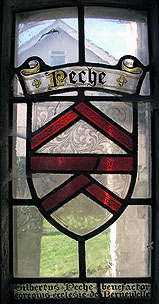 The Peverel inheritance was divided among coheiresses, Bourn, with Barnwell Priory, going eventually to the sons of Pain's daughter Alice, wife of Hamo Peche. (fn. 17) Richard Norel, the third prior, a pious simple man 'who could not bear the burden of government', resigned within two years and went to France. (fn. 18) His successor, Hugh Domesman, left a profound mark on the economic life of the priory. (fn. 19) At its first foundation it had little land, but was well endowed with churches; (fn. 20) after its second it possessed the original and the new site, and a considerable holding in Bourn. Soon
small donations from the people of Cambridge began to build up a demesne which at last included a third or more of the eastern, or
Barnwell Field, and much of the Cambridge Field across the river, (fn. 21) where Dunning, founder of the family which owned the 'School of Pythagoras', gave 50 acres. (fn. 22) Hugh Domesman himself gave 140 acres in the fields and many houses in the town—his whole patrimony from his father Osbert Domesman: (fn. 23) he also 'recovered' the church of Great Wenden in Essex for the canons and acquired land in Madingley. (fn. 24)
The Peverel inheritance was divided among coheiresses, Bourn, with Barnwell Priory, going eventually to the sons of Pain's daughter Alice, wife of Hamo Peche. (fn. 17) Richard Norel, the third prior, a pious simple man 'who could not bear the burden of government', resigned within two years and went to France. (fn. 18) His successor, Hugh Domesman, left a profound mark on the economic life of the priory. (fn. 19) At its first foundation it had little land, but was well endowed with churches; (fn. 20) after its second it possessed the original and the new site, and a considerable holding in Bourn. Soon
small donations from the people of Cambridge began to build up a demesne which at last included a third or more of the eastern, or
Barnwell Field, and much of the Cambridge Field across the river, (fn. 21) where Dunning, founder of the family which owned the 'School of Pythagoras', gave 50 acres. (fn. 22) Hugh Domesman himself gave 140 acres in the fields and many houses in the town—his whole patrimony from his father Osbert Domesman: (fn. 23) he also 'recovered' the church of Great Wenden in Essex for the canons and acquired land in Madingley. (fn. 24)
Hugh's successor, Robert (nicknamed 'Joel' for his harshness), ruled long and did much for the priory with the help of Sir Everard de Beche, (fn. 25) Sheriff of Cambridgeshire 1170-7, (fn. 26) one of its principal benefactors. He caused the unfinished conventual church to be pulled down, (fn. 27) and built a new one which was dedicated 1 April 1190 by William Longchamp, who granted an indulgence of 40 days. (fn. 28) The bishop also gave, or restored, the churches of Waterbeach, Caldecote, and the canons' first settlement at St. Giles. (fn. 29) This last the prior assigned for the infirmary and the minucio; (fn. 30) he also drew up new constitutions, established the daily Lady Mass, (fn. 31) and endowed the office of precentor with an annual rent of 3 marks. (fn. 32) These constitutions of Robert Joel may have been the first draft of the Observances of Barnwell, which are based upon the Customs of St. Victor. (fn. 33) It may also have been at about this time that a canon named Warin wrote a lost chronicle of the house which the author of the Liber Memorandorum quotes for the donation of Hugh Domesman. (fn. 34) Geoffrey Peche, nephew of William Peverel, who had inherited the patronage of the priory in 1185, (fn. 35) died in 1190, (fn. 36) shortly before the church was finished, as did Everard de Beche, whose tomb was made over against that of Pain Peverel, after whom he was reckoned as 'the second lover of that church' which he had helped Robert Joel to build. (fn. 37)
During the reign of Richard I Saher de Quincy, Earl of Winchester, gave the priory land and several villeins (including his huntsman) in Chesterton, (fn. 38) and on 27 April 1200 King John granted them that manor at a yearly rent of £30 blanch, on condition that a gift of £10 in alms, made a few months before, should be void. (fn. 39)
The Hundred Rolls also credit John with having granted the Barnwell, or Midsummer, Fair to the priory during the Interdict, (fn. 40) but this grant is not recorded in the
Liber Memorandorum, which speaks of an earlier festival at the 'Bairns' Well',
(fn. 41) and the alleged charter of Henry II confirming the fair for four days 'from the vigil of St. Etheldreda in summer', relied on when, in 1299, the prior was called upon to prove his right to Barnwell Fair, (fn. 42) was probably that actually given by Henry III in 1229. (fn. 43) Robert resigned after 33 years as prior, and lived in retirement for about 3 years more: (fn. 44) William of Devon, who succeeded him, occurs 1202. (fn. 45)
In March 1203 King John lodged at the priory; (fn. 46) Henry III was at the priory several times, (fn. 47) and in 1267 his brother, the King of the Romans, was there. (fn. 48) When, in 1293 Edward I stayed at the castle, instead of at Barnwell, for two whole days, it was said that this had not been done before within the memory of man. (fn. 49) In November 1296 he was again at the priory. (fn. 50) Wine, of the king's gift, was sent from Boston on several occasions. (fn. 51)
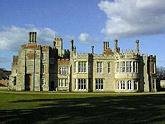 The Cromwell Family at
Hinchingbrooke
- The History of Hinchingbrooke House
The Cromwell Family at
Hinchingbrooke
- The History of Hinchingbrooke House
The remnants of Barnwell and Ramsey Abbey.....
The first known building on the site was a Norman church dated to about the
year 1100.It was originally called the Priory of St. James. By about the year
1200 it had been converted to a Benedictine Nunnery and remained so until about
1536. Remains of the nunnery still exist in the present building, notably the
stone coffins of two nuns which can still be seen under the stairs of the
present building.
With the Priory now closed it was in 1538 that Richard Williams alias
Cromwell received a royal grant of the priory with its “church, steeple,
churchyard and house and all lands.” Sir Richard Cromwell died in 1545.
He had acquired Ramsey Abbey, Hinchingbrooke and lands of other religious
houses
Sir Henry Cromwell - He pulled down part of the nunnery and erected a fine Elizabethan house surrounded by an open court in its place.
The new building was mainly made of materials brought from Barnwell Priory, particularly the gilded roof of the great dining-hall. Because of his generosity and magnificence Sir Henry Cromwell was known in his day as the Golden Knight, and it is said that in his journeys from Hinchingbrooke to Ramsey Abbey, his summer residence, he threw money out of his coach to the people who collected to see him pass. He entertained Queen Elizabeth here in 1564
Elizabeth spent the night of August 10th 1564 at Hinchingbrooke, after a four day visit to
Cambridge.
The original church, at 85 by 19 feet, was remodeled into a long gallery and
divided into two floors. Sir Henry aimed to make Hinchingbrooke into a Tudor
"prodigy" country house to reflect his increasing self importance. The
gatehouse (from Ramsey Abbey) would be an imposing entrance to the outer
courtyard and an inner courtyard (now the covered inner hall) would balance it
in a typically Tudor design
Cambridge, St Andrew the Less - Barnwell Priory Remnants
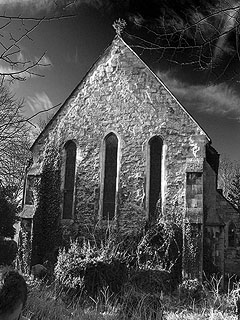 St
Andrew's sits next to the dreadful Newmarket Road, choking on the car fumes.
This is now one of the less salubrious bits of Cambridge, stuck between a
megastore wasteland and the Four Lampposts Roundabout. It's also known as 'The
Abbey Church' - which must be a reference to the fact that this area was
the site of Barnwell Priory. This was an Augustinian house which started its
life up near the Castle in 1092 and was quickly moved to this more spacious site
near the river in 1112.
St
Andrew's sits next to the dreadful Newmarket Road, choking on the car fumes.
This is now one of the less salubrious bits of Cambridge, stuck between a
megastore wasteland and the Four Lampposts Roundabout. It's also known as 'The
Abbey Church' - which must be a reference to the fact that this area was
the site of Barnwell Priory. This was an Augustinian house which started its
life up near the Castle in 1092 and was quickly moved to this more spacious site
near the river in 1112.
It took until 1190 to finish the priory church of St Andrew, though whether this is due to magnificence or penury (or both) I haven't been able to find out.
In 1211, King John granted a charter to the priory to hold a fair every Midsummer, and this assured the house's prosperity until 1506, when the city burgesses managed to wrest control of the fair from the monks. The fair still survives today, although its trading activities were gradually replaced by amusements in the latter half of the 19th century.
The priory itself fell in the dissolution, of course. Of the extensive buildings the only remains are the present church (once a chapel on the south side of the site) and a claustral building (the nicely vaulted Cellarar's Checker which sits forlornly at the corner of Beche Road and Priory Road).
 The rest was taken away for use by the colleges and local gentry - the
Cromwells took a gilded ceiling to Hinchingbrooke House, where it can still be
seen. Most of the site was finally levelled in the early 19th century.
The rest was taken away for use by the colleges and local gentry - the
Cromwells took a gilded ceiling to Hinchingbrooke House, where it can still be
seen. Most of the site was finally levelled in the early 19th century.
The church itself is a tiny building - just a nave and a chancel - and although much of the building is 13th century, it had quite an aggressive going-over from the Victorians. The whole of the north side is rebuilt, and the windows on the south side are all obviously neo-Gothic. The south doorway is transitional, but the porch that shields it is from the 1920s and exceedingly boring. In the west wall there are some original lancet windows, and above them the bells hang in a little double-lancet at the apex of the wall. This would be rather nice except that they are now 'protected' by an ugly wire cage. St Andrew's is now in a united parish with Christchurch a few hundred yards to the west, and they only hold services here once a month
.Hinchingbrooke House - The new building was mainly composed of materials brought from Barnwell Priory, particularly the gilded roof of the great dining-hall
Parishes - Barnwell St. Andrew British History Online
Manors
A charter of Edward the Confessor confirmed BARNWELL ST. ANDREW to Ramsey Abbey as the gift of Ethelric, Bishop of
Dorchester, (fn. 10) who died in 1034; (fn. 11) William I and Edward III also confirmed this grant. (fn. 12) At the Domesday Survey (1086) and again in the 11th century, the land of St. Benedict of Ramsey included six hides in
Barnwell.
Barnwell, Northamptonshire - Barnwell (formerly Barnwell All Saints and Barnwell St Andrew) is a village in the district of East Northamptonshire in England, 2 miles (3.2 km) south of the town of Oundle, 78 miles (126 km) north of London (via the A1 road) and 14 miles (22.5 km) south-west of Peterborough. The River Nene runs north of the village separating it from Oundle.
Barnwell Castle is in the northern part of the village and believed to have been built around 1266. It is describe as 'the first example in Britain of the most monumental type of castle architecture[2].
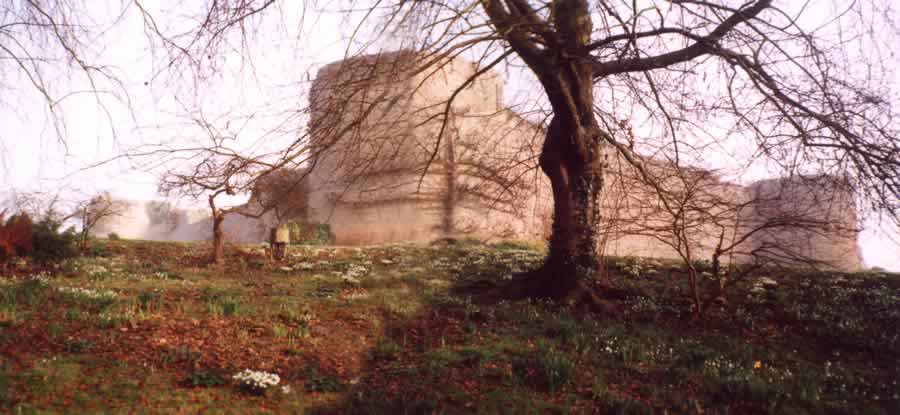
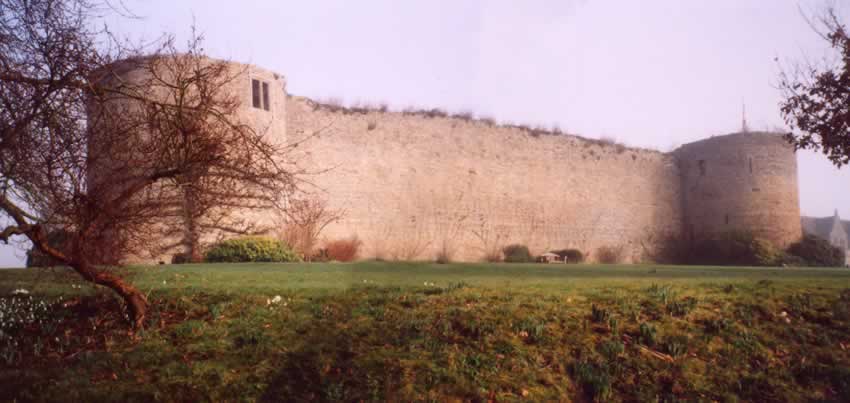
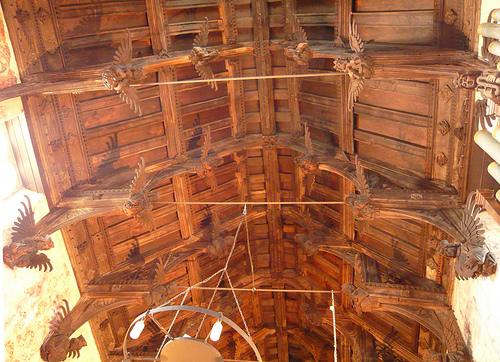 Barnwell
Priory's Roof - this was taken and re-used in another building -
Barnwell
Priory's Roof - this was taken and re-used in another building -
Angel
Roof, St.
Mary and All Saints, Willingham, Cambridgeshire
The double hammer beam roof is thought to have been made in the fifteenth
century and was obtained second-hand from the demolished Barnwell Priory
in Cambridge in 1613. Unfortunately the weight of the roof caused the walls
to 'spread', so tie rods were installed in the late 19th century to prevent
further spreading. The angels are 19th and 20th century, the originals didn't
come with the roof when it was brought from Barnwell (flat-pack furniture
had bits missing even then and it takes ages to get spares, although I'd have
complained after 300 years).
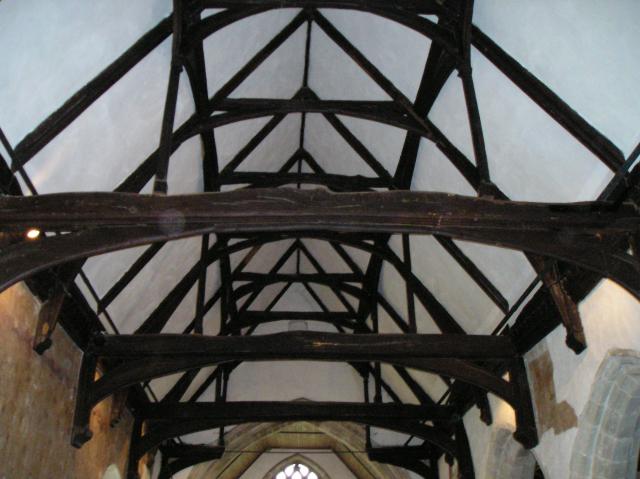 History
of Rampton Church All Saints' Church, Rampton, Cambridgeshire
History
of Rampton Church All Saints' Church, Rampton, Cambridgeshire
The next major alteration was the addition of the current 'Queen post' roof. It is clear that the beams of the roof were not originally designed for this church; the beams are not centred in between the arches and the beams have been crudely cut to fit the shapes of the chancel and tower arches. The roof is reputed to have originally been part of a building at Barnwell Priory that was destroyed during the Reformation. The roof fits All Saints rather imperfectly, being rather steeply pitched and it is to this that we owe the survival of the thatch; The roof and walls could not support the weight of tiles.
Esthattele is East Hatley (In Cambridge) and the church was St. Denis:
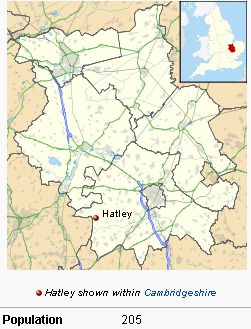
 1339 - The
parson of the church of Potton was robbed in 1339 of wheat, barley, beans,
peas and other goods and chattels to the value of forty marks by William, son of
William de Hurle of Potton, John Wymond of Potton and John Lettice of Potton,
The same William
de Hurle and another assaulted Reginald Outlawe, parson of the church of
Esthattelee at
Potton and wounded him, and William was presented as a common
assaulter and disturber of the peace. - THE
LANDS OF THE SCOTTISH KINGS IN ENGLAND - Potton
- Wikipedia
1339 - The
parson of the church of Potton was robbed in 1339 of wheat, barley, beans,
peas and other goods and chattels to the value of forty marks by William, son of
William de Hurle of Potton, John Wymond of Potton and John Lettice of Potton,
The same William
de Hurle and another assaulted Reginald Outlawe, parson of the church of
Esthattelee at
Potton and wounded him, and William was presented as a common
assaulter and disturber of the peace. - THE
LANDS OF THE SCOTTISH KINGS IN ENGLAND - Potton
- Wikipedia
1340 - Presentation of Reginald le Outlawe, parson of the church of Esthattele, in the diocese of Ely, to the church, of Risshenden, in the diocese of Lincoln, in the king's gift by reason of the temporalities of the priory of Lenton being in his hands, oni an exchange of benefices with Hugh de Luffenham. [ Esthattele seems connected to Barnwell Abbey - St Michaels Cambridge - St John's Hospital - John de Hattele - Estenhale: its eastern extremity towards Barnwell Priory was called Estenhale]
So the question is - What was the "church of Esthattele" ( in the diocese of Ely) ? I haven't found any records.... Well it looks like "Hattele" is Hatley and Esthattele is East Hatley - Cambridgshire and that the "church" was St. Denis in East Hatley...
Hatley, Cambridgeshire - Hatley is a civil parish in South Cambridgeshire, England. It lies between the villages of Gamlingay and Croydon, 12 miles south-west of the city of Cambridge and eight miles south-east of the town of St Neots. ... The Hatley name was in use as early as 986,[1] derived from 'laie' or 'ley', a woodland clearing,[2] or 'woodland clearing on the hill'.[3] The spelling Hatelaie was used in the 1086 Domesday Book.
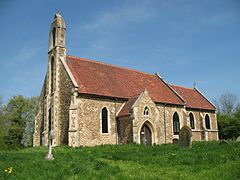 Church
of St Denis, East Hatley
Church
of St Denis, East Hatley
East Hatley is a row of houses along a smaller road. It was formerly known as Castell Hatley.[15] In 1929, the hamlet was owned by the Master and Fellows of Downing College, Cambridge.[16] Sir George Downing, 1st Baronet, after whom Downing Street is named, owned land in East Hatley (his grandson, Sir George Downing, 3rd Baronet, founded Downing College).[2]
CHURCH OF ST DENIS, - Detailed Record
Hatley St George and East Hatley - St. Denis church – also Grade II* listed and now an empty shell no longer in use and on the English Heritage Buildings at Risk register, although the churchyard is still consecrated – retains its moat; other moats can be seen from the road near Manor Barn and The Palace. - A feature of the Hatleys is that the more important buildings were once surrounded by moats. These can still be seen, especially in East Hatley. St. Denis's church in East Hatley retains its moat, as do the ruins of what is thought to be Quy manor in the ancient Buff Wood, which in 1086 belonged to Picot, the sheriff of Cambridge.... Their lands in East Hatley passed to Sir George Downing, after whom Downing Street is named and whose grandson's money paid for the foundation of Downing College, Cambridge
Taken from Archaeology of Cambridgeshire , Vol. 1: South West Cambridgeshire, by Alison Taylor, pp 68-71. Published by Cambridgeshire County Council, 1977. ISBN 1-870724-84-4.
Possibly "The Rectory" part of the Downing Estate now....
Parishes - East Hatley British History Online - ... The living,
although it always remained a rectory, was not wealthy in the Middle Ages.
It was worth only £5 or less in the 13th century, (fn. 142) and £7 16s. 6d. in
1535. .
The rectory house formerly stood within a moat just south of the manor house. (fn. 152) In the 1660s it had 4 hearths. (fn. 153) It was dilapidated in 1722, (fn. 154) and although inhabited by the rector in 1728 and 1775, (fn. 155) was described in 1807 as a miserable cottage, unfit for a clergyman's family. (fn. 156) It was burnt down in 1821 and not rebuilt, (fn. 157) the incumbents thereafter living at Tadlow.
From the 14th century the parish proved too poor to keep incumbents long. Between 1340 and 1345 there were five rectors: the last was absent in 1347 in his patron's service. (fn. 158) In 1349 a fellow of Michaelhouse, Cambridge, held the cure. (fn. 159) One chaplain served in 1378 for the sometimes absentee rector. (fn. 160) Another rector was licensed in 1384 to be away for 3 years, to study at Cambridge or attend his patroness. (fn. 161) Between 1390 and 1398 three more rectors quitted the parish by exchange (fn. 162) and another in 1435 left it for a London chantry. (fn. 163) The St. Georges began to present graduates after 1500. (fn. 164) A cottage given for an obit was sold in 1550 and the church house c. 1577. (fn. 165)
The old church, named after ST. DENIS by the 18th century, (fn. 184) was built of field stones dressed with clunch. It had only a short chancel and nave with south porch. (fn. 185) The church was probably built mainly late in the 13th century, although reconsecrated in 1352
GENUKI East
Hatley, Cambridgeshire - The living is a rectory in the
diocese of Ely, value £175, in the patronage of the Master and Fellows
of Downing College, Cambridge, who are lords of the manor and owners of the
parish. The church is dedicated to St. Dennis.
...
The church of St. Denis is a building of stone in the Early English
style, consisting of chancel, nave, north and south porches and a western tower
containing one bell: the chancel dates from 1260 and the nave from 1200
Hatley St George and East Hatley
... There are no visible remains of the mediæval village apart from the crumbling walls of the church of St
Denis which closed 40 or more years ago, while its graveyard is still in use. Next to it is the old farmhouse which took the manor name and perhaps contains a few timbers of the house once occupied by
East Hatley's most famous connection, Sir George Downing.
Sir George was given his baronetcy by Charles II after he adroitly switched sides after the Civil War. He is mentioned, not to his advantage, in Samuel Pepys' famous diary. He has left a carving of his arms with the date 1653 inside the porch of the church and his name is known nationally, not only because of
Downing Street, but because his grandson, the third Sir George, left the family fortune to found Downing College,
Cambridge.
It was the College which managed the farming estate of East Hatley from the early 1800s until 1947, when the land was divided up and sold. Before that, in the 1860s, was built the last house of the village street, nicknamed The Palace by locals. This was used by the farming and hunting Bursar on his visits. A flamboyant character, Dr John Perkins was laid to rest in the churchyard in 1901.
Both the churchyard and the field next to The Palace are surrounded by moats. Within the latter stood the parsonage which burned down in 1821.
Mysteriously, and surprisingly, there were once 12 or 13 moats in East
Hatley.
We now reach another part of Buff Wood, where the remains of another manor house have been identified. Walking round the wood's outer edge will reveal some of the wide arable landscape of Bedfordshire and beyond. We turn eventually up Buff Lane (the old “hundred” boundary) and arrive again at Hatley St George.